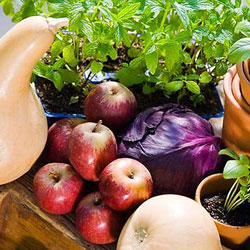 Believe it or not, eating organic food does not have to be overly expensive. With ever-growing awareness, organic options are more accessible than ever before and consumer demands have led to increased affordability.
Believe it or not, eating organic food does not have to be overly expensive. With ever-growing awareness, organic options are more accessible than ever before and consumer demands have led to increased affordability.
Note: If you’re unsure about the value of buying organic, please see my post “Is Organic A Con?”
. . . . .
Here are some handy tips that help reduce the cost of organic fruit and vegetables…
1. Buy Unpackaged Foods
More and more organic grocery stores have package-free bulk dispensers for items like nuts, beans, lentils, coffee grounds, and even cereal. You can buy the exact amount you need at a lower price point than the packaged counterpart of these items. You do not waste money on brand names, their fancy packaging and big advertising campaigns. Plus, if you bring your own bags, you’re also helping out the environment.
2. Buy in Bulk
Get clever, buy together! Do you have like-minded friends or neighbours who would be interested in bulk organic produce? You can purchase everything from grains to fruits and nuts in bulk. As long as you have room to store bulk items, you can save a great deal of money. You could even stew and freeze certain fruits.
3. Stock Up on Pantry Items
If you keep a hefty supply of organic flour, cocoa, nuts, oatmeal, and dried fruit, it’s easy to whip up your own organic muffins, snacks or a sweet indulgence at a fraction of the price you’d pay dining out or on the run.
4. Skip Processed Items
“Organic” doesn’t always mean healthy; unless products such as organic snack items say 100% organic ingredients then you may find hidden nasties. Just like generic snacks, organic packaged foods are expensive. Stick with real fresh organic products or brands you know you can trust.
5. Look for Store Brands
In addition to their standard generic lines, supermarkets are now carrying their own line of organic products, including organic diced tomatoes, baked beans etc sometimes for much lower prices than big name brands.
6. Shop at a Farmers’ Market
At a farmers’ market you are buying directly from the person growing the produce, so presumably the produce will be fresher and you do not have to worry about supermarket mark-ups.
7. Grow Your Own
While maintaining a home garden takes commitment (this is a fantastic way to engage children in healthy eating) there are some maintenance-free plants that make it easy to get started even if you don’t have a green thumb. Most gardening centre’s will be only too willing to give advice and guide you toward them. Once growing season is over, you can even learn how to can and store your fruits and veggies for good, cheap eating throughout the year.
Weighing it up…
I have seen that when a parent considers the potential health risks of consuming generic foods and produce, they will often make changes to their weekly expenses to accommodate at least some organic items.
If I ask parents to:
- Estimate the cost of the bottles of soft drinks, expensive snack food items, alcohol, cigarettes or magazines that may fill their shopping trolleys
- Add up the cost of their annual footy tickets, gym memberships
- Or estimate what they spend on prescription and over-the-counter drugs and the cost for time off work when children are sick
Against the cost of purchasing even SOME organic produce, I’m sure most people would agree that their budget could be reprioritized.
Purchasing organic food is not a luxury
but rather an integral step in securing our health.
. . . . .
From the desk of…
Jennifer Barham-Floreani
Bach. Chiropractic, Bach. App Clinical Science
Registered internationally, no longer practicing as a chiropractor in Australia.
. . . . .



 Believe it or not, eating organic food does not have to be overly expensive. With ever-growing awareness, organic options are more accessible than ever before and consumer demands have led to increased affordability.
Believe it or not, eating organic food does not have to be overly expensive. With ever-growing awareness, organic options are more accessible than ever before and consumer demands have led to increased affordability.
